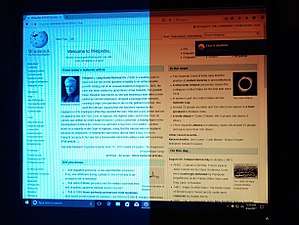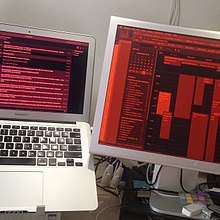f.lux
f.lux (pronounced "flux") is a cross-platform computer program that adjusts a display's color temperature according to location and time of day, offering functional respite for the eyes. The program is designed to reduce eye strain during night-time use, helping to reduce disruption of sleep patterns.[2][3]
 | |
 Two photos of a screen affected by f.lux's default settings (on the right) and disabled (on the left), stitched together | |
| Original author(s) | Michael Herf, Lorna Herf |
|---|---|
| Developer(s) | F.lux Software LLC |
| Initial release | February 2009 |
| Stable release | |
| Operating system | Windows, macOS, Linux, Android, iOS |
| Available in | English |
| License | Freeware |
| Website | justgetflux |
Functionality

Upon installation, the user can choose a location based on geographic coordinates, a ZIP code, or the name of a location. The program then automatically calibrates the device display's color temperature to account for time of day, based on sunrise and sunset at the chosen location. At sunset, it will gradually change the color temperature to a warmer color and restore the original color at sunrise.[2][3]
f.lux offers a variety of color profiles and pre-defined temperature values, modifying program behaviour for specific programs or activities; including a mode for film watching, decreasing red tinge (for 2.5 hours), and a darkroom mode that does not affect night-adapted vision.[2][3] Times can be inverted on f.lux for PC to provide warm lighting during the daytime (for people who work at night).[4] The program can control Philips Hue LED lighting, so that the color temperature of house lights follows f.lux's settings.[5]
Platforms
The program is available for Microsoft Windows, macOS and Linux (except for Ubuntu 18.04 LTS). It is also available for iOS devices, although it requires the device to be jailbroken.[6] Apple has not allowed the application in its App Store due to its use of restricted developer tools.[7] The developer briefly hosted an Xcode project on GitHub, allowing iOS 9 users to sideload the application onto their devices, but retracted it at the request of Apple.[8] Following Apple's announcement of a similar function, called Night Shift, in iOS 9.3, the developer called upon Apple to provide developer tools and to allow their application into the App Store.[9] A preview version for Google's Android system is available.[10]
Efficacy
f.lux proponents hypothesise that altering the color temperature of a display to reduce the prominence of white–blue light at night will improve the effectiveness of sleep. Reducing exposure to blue light at night time has been linked to increased melatonin secretion.[11] Although the developer provides a list of relevant research on their website, the program itself has not been scientifically tested to determine its efficacy. In spite of this, f.lux has been widely and positively reviewed by technology journalists, bloggers, and users.[2][3][6]
See also
- Electronic media and sleep
- Oswald Labs § Agastya
- Purkinje effect § Use of red lights
- Red Moon (software)
- Redshift (software)
References
- "f.lux for iOS". f.lux. Retrieved October 13, 2018.
- Zukerman, Erez (October 31, 2013). "Review: f.lux makes your computer usable at night". PC World. Retrieved 3 March 2015.
- Tanous, Jim (October 15, 2014). "Save Your Eyes and Improve Your Sleep with f.lux for OS X and Windows". TekRevue. Retrieved January 15, 2016.
- "f.lux: F.A.Q. - I work nights. How do I flip the day and night settings?". justgetflux.com. Retrieved 31 October 2016.
- "f.lux has been updated to a new version". justgetflux.com. Retrieved 31 October 2016.
- Hoffman, Chris (October 23, 2014). "Reduce Eye Strain and Get Better Sleep by Using f.lux on Your Computer". How-To Geek. Retrieved January 15, 2016.
- Hern, Alex (January 12, 2016). "Apple promises a good night's sleep with new iPhone feature". The Guardian. Retrieved January 20, 2016.
- Tepper, Fitz (November 12, 2015). "F.uxd: Apple Says Screen Brightness App Violates Developer Agreement". TechCrunch. Retrieved January 15, 2016.
- Perez, Sarah (January 15, 2016). "F.lux Asks Apple To Let Its Screen Color Adjustment App Back Into App Store". TechCrunch. Retrieved January 20, 2016.
- "f.lux Home Page". f.lux. Retrieved September 21, 2016.
- Takeshi, Morita; Hiromi, Tokura (1996). "Effects of Lights of Different Colour Temperature on the Nocturnal Changes in Core Temperature and Melatonin in Humans". Journal of Physiological Anthropology. 15 (5): 243–6. PMID 8979406.
External links
- Official website
- The Benefits of Avoiding Blue Light Before Bedtime: how filtering out blue light from screens improves sleep quality.